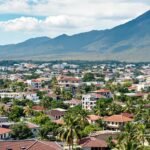Mexico’s Pueblos Mágicos (Magical Towns) program continues to draw visitors to the country’s most charming and historically significant small towns, with 177 designated locations now spread across the nation.
The program, launched in 2001, highlights towns that offer natural beauty, cultural richness, history, archaeology, cuisine, and the arts. The federal Ministry of Tourism (Sectur) plans to implement higher standards this year for obtaining and maintaining the coveted designation.
Notable Pueblos Mágicos
Among the most notable Pueblos Mágicos are:
- Valle de Bravo: Located about 2.5 hours from Mexico City, this lakeside town features distinctive whitewashed houses with terracotta roofs. Activities include kayaking, visiting nearby monarch butterfly sanctuaries, and hiking Nevada de Toluca volcano.
- Jalpán: Situated in the Sierra Gorda mountains, it serves as a gateway to five 17th-century Franciscan missions. Visitors can explore these architectural treasures along with the Tancama ruins, an important pre-Hispanic settlement dating from 200-900 CE.
- Cuetzalán: A remote village in Puebla state, it is known for its weekly market and traditional “voladores” ritual, where performers climb a 100-foot pole and spiral down in a ceremony dating back to pre-Hispanic times.
- San Sebastián del Oeste: A former mining town in the Sierra Madre mountains near Puerto Vallarta, offering well-preserved colonial architecture, historic haciendas, and cobblestone streets that transport visitors to another era.
The Pueblos Mágicos program continues to evolve, with Sectur working to ensure these destinations maintain their unique character while providing authentic cultural experiences for both domestic and international visitors.
For more information, visit the source.


Leave a Reply